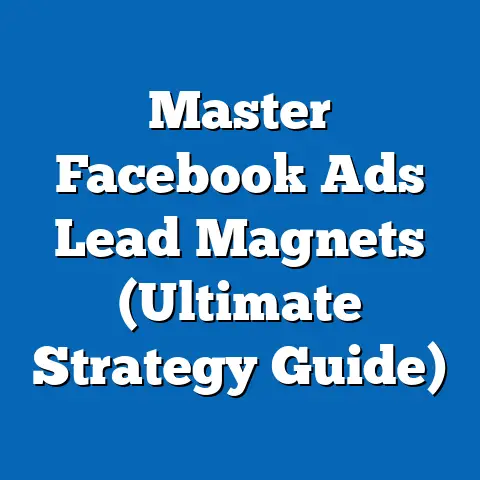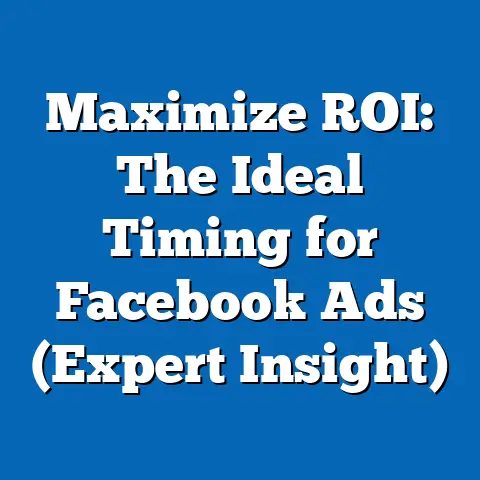Unlock Best Facebook Ads Audience (Expert Strategies)
Unlocking the Best Facebook Ads Audience: Expert Strategies with a Focus on Pet Owners
Part 1: Understanding Pet Owners as a Key Demographic for Facebook Ads
Defining Characteristics of Pet Owners
Pet owners, often referred to as “pet parents” in modern marketing vernacular, are individuals who own and care for domestic animals such as dogs, cats, birds, or exotic pets. This demographic spans a wide range of ages, income levels, and geographic locations, but they are united by a shared emotional bond with their pets. According to the American Pet Products Association (APPA), approximately 70% of U.S. households own a pet as of 2023, translating to over 90 million households—a figure that underscores the vast potential of this audience.
A key characteristic of pet owners is their high level of emotional investment in their animals’ well-being. Many view their pets as family members, often prioritizing their pets’ needs over discretionary spending on themselves. This emotional connection drives purchasing behaviors, with pet owners spending billions annually on pet food, grooming, veterinary care, and accessories.
Additionally, pet owners tend to be active on social media, frequently sharing photos, videos, and stories about their pets. A 2022 survey by Rover found that 65% of pet owners post about their pets on social media at least once a week, making platforms like Facebook a natural hub for engagement. This behavior provides marketers with rich, user-generated content to leverage in ad campaigns.
Historical Context: The Evolution of Pet Ownership
The relationship between humans and pets has evolved significantly over centuries, influenced by cultural, economic, and technological changes. In pre-industrial societies, animals were primarily kept for utilitarian purposes—dogs for hunting or guarding, cats for pest control. The concept of pets as companions emerged more prominently in the 19th century, particularly in Western societies, as urbanization and industrialization created a middle class with disposable income and leisure time.
The advent of the internet and social media further transformed pet ownership, creating online communities where pet owners could connect, share advice, and celebrate their pets. Platforms like Facebook became virtual spaces for pet-related groups, pages, and events, amplifying the visibility of this demographic. Today, pet ownership is not just a lifestyle choice but a cultural phenomenon, with pets often serving as emotional support systems in an increasingly fast-paced, disconnected world.
Societal Implications of Pet Ownership
The rise in pet ownership has far-reaching implications for society, economics, and individual well-being. Economically, the pet industry is a powerhouse, with the APPA reporting that U.S. pet owners spent $136.8 billion on their pets in 2022, a figure projected to grow annually. This spending spans categories like premium pet food, pet tech (e.g., GPS collars), and pet insurance, reflecting a willingness to invest in high-quality products and services.
Socially, pets play a critical role in fostering community and reducing loneliness. Studies, such as those published in the Journal of Personality and Social Psychology, have shown that pet ownership can alleviate stress, anxiety, and depression, particularly among Millennials and Gen Z, who face unique mental health challenges. Pets also facilitate social interactions—dog owners, for instance, often connect with others at parks or through local pet meetups, creating micro-communities that can be targeted through localized Facebook Ads.
From a cultural perspective, the humanization of pets has led to shifts in how society views animal welfare. Advocacy for pet adoption, anti-cruelty laws, and ethical sourcing of pet products have gained momentum, influencing consumer behavior. Marketers must be mindful of these values, ensuring that campaigns align with ethical standards to avoid alienating this passionate audience.
Diversity Within the Pet Owner Demographic
While pet owners share a common bond, they are far from monolithic. Generational differences play a significant role in their behaviors and preferences. For instance, Baby Boomers often own pets as companions in retirement, prioritizing health-related products like joint supplements for aging dogs. Millennials, on the other hand, are more likely to adopt pets as “fur babies,” splurging on trendy accessories and organic pet food, according to a 2021 Nielsen report.
Geographic and socioeconomic factors also create diversity within this group. Urban pet owners may prioritize compact, pet-friendly products due to space constraints, while rural owners might focus on outdoor gear for their animals. Income levels further influence spending—high-income households may opt for luxury pet services, while budget-conscious owners seek affordable yet reliable options. Understanding these nuances is critical for segmenting audiences on Facebook and delivering personalized ad content.
Part 2: Why Pet Owners Are a Prime Target for Facebook Ads
High Engagement on Social Media
Pet owners’ active presence on social media makes them an ideal audience for Facebook Ads. The platform’s robust targeting tools allow marketers to reach pet owners through interests (e.g., “dog lovers,” “cat care”), behaviors (e.g., purchasing pet products), and demographics (e.g., age, location). Moreover, pet-related content often garners high engagement—posts featuring cute or funny pet moments frequently go viral, providing organic reach opportunities for brands.
Facebook Groups are another goldmine for targeting pet owners. With millions of members in groups like “Dog Lovers Unite” or “Cat Owners Community,” brands can engage directly with passionate audiences. Sponsored posts or ads within these groups can feel less intrusive and more community-driven, fostering trust and brand loyalty.
Emotional Triggers in Advertising
The emotional connection pet owners feel toward their animals is a powerful lever for marketers. Ads that evoke feelings of love, care, or humor—such as a video of a dog enjoying a new toy—can drive higher click-through rates (CTR) and conversions. A 2020 study by Socialbakers found that pet-related ads on Facebook had a 15% higher engagement rate compared to non-pet ads in similar industries like retail or lifestyle.
However, marketers must tread carefully to avoid exploiting emotions. Ads perceived as manipulative or insensitive to animal welfare can backfire, leading to negative sentiment and brand damage. Authenticity and empathy are key to resonating with this audience.
Economic Potential of the Pet Market
The sheer size of the pet industry makes pet owners a lucrative target for Facebook Ads. With spending projected to reach $150 billion in the U.S. by 2025, according to Statista, businesses ranging from pet food manufacturers to grooming services have a vast opportunity to capture market share. Facebook’s cost-effective advertising model, combined with its precise targeting capabilities, allows even small businesses to compete with larger brands in this space.
Part 3: Expert Strategies for Unlocking the Best Facebook Ads Audience
Having established pet owners as a prime demographic, this section broadens the focus to expert strategies for targeting any audience on Facebook, while incorporating lessons learned from the pet owner segment. These strategies are grounded in data, best practices, and insights from industry leaders.
1. Leverage Advanced Audience Segmentation
Facebook’s Ads Manager offers unparalleled tools for audience segmentation, allowing marketers to drill down into specific demographics, interests, and behaviors. Start by creating a core audience based on basic parameters like age, gender, and location. Then, refine this audience using detailed targeting options— for pet owners, this might include interests like “pet adoption” or “veterinary services.”
Lookalike Audiences are another powerful tool. By uploading a list of existing customers (e.g., pet product buyers), Facebook can identify users with similar characteristics, expanding your reach to potential customers who share traits with your best audience. A 2021 case study by HubSpot found that Lookalike Audiences increased conversion rates by 30% for e-commerce brands targeting niche markets like pet supplies.
Finally, use Custom Audiences to retarget users who have interacted with your brand—such as those who visited your website or engaged with previous ads. Retargeting campaigns for pet owners might feature ads for complementary products (e.g., dog treats after a toy purchase), capitalizing on their recurring spending habits.
2. Craft Emotionally Resonant Content
Emotional storytelling is a cornerstone of effective Facebook Ads, as seen with pet owners. For any audience, identify the emotional drivers that influence their decisions—whether it’s a desire for security, belonging, or joy. Use high-quality visuals and copy that evoke these emotions, ensuring the content feels authentic rather than overly promotional.
A/B testing is crucial here. Test different ad creatives—videos, carousels, static images—with varying emotional tones to see what resonates most. For pet owners, a video of a happy dog playing with a new toy might outperform a static image of the product alone. According to Facebook’s own data, video ads drive 20-30% more engagement than other formats, making them a go-to for emotional storytelling.
3. Optimize for Mobile and Dynamic Ads
With over 98% of Facebook users accessing the platform via mobile devices (Statista, 2023), optimizing ads for smaller screens is non-negotiable. Use vertical or square formats for visuals, keep text concise, and ensure call-to-action (CTA) buttons are prominent. For pet owners, mobile-optimized ads might feature quick, engaging videos that play automatically in the News Feed, capturing attention during brief scrolling sessions.
Dynamic Ads take this a step further by automatically personalizing content based on user behavior. For example, if a pet owner browsed cat food on your website, a Dynamic Ad could display that exact product or related items. This personalization increases relevance and conversion rates—Facebook reports that Dynamic Ads can boost ROI by up to 34% compared to standard ads.
4. Utilize Facebook Pixel for Data-Driven Insights
The Facebook Pixel is an indispensable tool for tracking user behavior and measuring ad performance. By installing the Pixel on your website, you can monitor actions like page views, add-to-carts, and purchases, gaining insights into what drives conversions. For pet owners, Pixel data might reveal that users who view dog grooming services are more likely to convert after seeing a discount offer, allowing you to tailor future campaigns.
Use these insights to refine your audience targeting and ad creative. Combine Pixel data with Facebook Analytics to understand broader trends, such as peak engagement times or demographic preferences, ensuring your campaigns are data-driven rather than speculative.
5. Experiment with Ad Placements and Budget Allocation
Facebook offers a variety of ad placements—News Feed, Stories, Marketplace, and Audience Network—each with unique strengths. Test different placements to see where your audience engages most. For pet owners, Stories might work well for quick, visually appealing ads, while Marketplace could target users actively shopping for pet products.
Budget allocation is equally important. Start with a modest budget to test campaigns, then scale up for high-performing ads. Facebook’s Campaign Budget Optimization (CBO) tool can automatically distribute your budget across ad sets to maximize results, a strategy that has proven effective for niche audiences like pet owners, according to a 2022 report by Social Media Examiner.
6. Incorporate User-Generated Content (UGC)
UGC is a powerful way to build trust and authenticity, particularly for emotionally invested audiences like pet owners. Encourage customers to share photos or reviews of your products, then feature this content in your ads with permission. For instance, a pet brand might run a contest asking owners to post pictures of their pets using the product, then repurpose winning entries as ad creatives.
UGC not only reduces content creation costs but also boosts engagement—consumers are 2.4 times more likely to trust UGC over brand-created content, per a 2021 Stackla survey. This strategy can be applied beyond pet owners to any audience with strong community ties, such as fitness enthusiasts or hobbyists.
7. Monitor Trends and Adapt to Platform Changes
Facebook’s algorithm and advertising policies are constantly evolving, requiring marketers to stay agile. Regularly monitor industry news and platform updates to adapt your strategies. For example, the 2021 iOS 14 update, which limited ad tracking, forced marketers to rely more on first-party data and contextual targeting—a shift that benefits niche audiences like pet owners, who can be targeted via interest-based groups.
Additionally, keep an eye on cultural trends. For pet owners, the growing focus on sustainability might prompt ads for eco-friendly pet products. Adapting to these trends ensures your campaigns remain relevant and effective, regardless of the target audience.
Part 4: Implications for Marketers and Society
Marketing Implications
The strategies outlined above, while rooted in the pet owner demographic, have broader implications for digital marketing. First, they highlight the importance of emotional connection in advertising—a principle that applies to any audience with strong personal values or passions. Marketers must prioritize authenticity and empathy to build trust, especially in an era of ad fatigue and skepticism.
Second, the pet owner case study underscores the value of niche targeting. While broad campaigns can generate reach, hyper-focused ads often yield higher engagement and ROI. Marketers should leverage Facebook’s tools to identify and nurture niche segments within larger audiences, whether it’s pet owners, gamers, or eco-conscious consumers.
Finally, the pet industry’s economic growth signals a larger trend: consumers are increasingly willing to spend on lifestyle and passion-driven purchases. Marketers across industries can learn from this, tailoring campaigns to tap into personal identities and emotional drivers.
Societal Implications
Beyond marketing, the focus on pet owners reflects broader societal shifts. The humanization of pets mirrors a growing need for companionship and emotional support, particularly among younger generations facing social isolation. This trend may influence other industries, from mental health services to urban planning (e.g., pet-friendly spaces), creating new opportunities for targeted advertising.
Moreover, the rise of pet-related communities on platforms like Facebook highlights the role of social media in fostering connection. As virtual communities grow, they offer marketers a space to engage authentically, but they also raise ethical questions about privacy and data use. Balancing commercial goals with respect for user trust will be critical for sustainable advertising practices.
Part 5: Conclusion and Forward-Looking Insights
Unlocking the best Facebook Ads audience requires a deep understanding of demographic nuances, as exemplified by the pet owner segment. By combining emotional storytelling, advanced targeting tools, and data-driven optimization, marketers can craft campaigns that resonate with specific audiences while maximizing ROI. The pet owner demographic, with its emotional investment, social media engagement, and economic potential, serves as a model for targeting other niche groups with similar passion-driven behaviors.
Looking ahead, the landscape of Facebook advertising will continue to evolve, shaped by technological advancements, privacy regulations, and cultural shifts. While tools like AI-driven targeting and augmented reality ads hold promise, uncertainties remain—particularly around data privacy and user trust. Marketers must stay adaptable, prioritizing transparency and value-driven content to maintain audience loyalty.
For pet owners and beyond, the future of Facebook Ads lies in personalization and community engagement. As societal trends like sustainability and mental health awareness grow, campaigns that align with these values will likely see greater success. By embracing a nuanced, empathetic approach, marketers can unlock not just the best audience, but the best outcomes for their brands and society at large.






